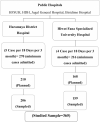Prevalence of Escherichia coli O157:H7 and associated factors in under-five children in Eastern Ethiopia
- PMID: 33508023
- PMCID: PMC7842931
- DOI: 10.1371/journal.pone.0246024
Prevalence of Escherichia coli O157:H7 and associated factors in under-five children in Eastern Ethiopia
Abstract
Background: Escherichia coli O157:H7 (E. coli O157:H7) is one of the most potent zoonotic pathogens that causes mild diarrhea and leads to hemolytic uremic syndrome or death. This study was aimed to assess the prevalence and determinants of E. coli O157:H7 related to diarrhea among under-five children with acute diarrhea.
Methods: A cross-sectional study design was carried out in 2018 on 378 under-five-year children recruited randomly from hospitals in Eastern Ethiopia. Stool specimens were collected and processed using enrichment, differential and selective medium. Among isolates, E. coli O157:H7 was confirmed using latex test (Oxoid, Basingstoke, Hants, England). Factors associated with E. coli O157:H7 infection were identified using binary and multivariable logistic regression. Associations were reported by odds ratio with 95% confidence interval.
Results: The prevalence of E. coli O157:H7 related diarrhea was 15.3% (95%CI: 11.8-19.5). The E. coli O157:H7 infection was positively associated with rural residence (AOR;3.75, 95%CI:1.26-11.20), consumption of undercooked meat (AOR;3.95, 95%CI: 1.23-12.67), raw vegetables and/or fruit juice (AOR;3.37, 95%CI:1.32-8.62), presence of bloody diarrhea (AOR;4.42, 95% CI:1.78-10.94), number of under-five children in a household (AOR;7.16, 95%CI: 2.90-17.70), presence of person with diarrhea in a household (AOR;4.22, 95% CI: 1.84-12.69), owning domestic animal (AOR;3.87, 95% CI: 1.48-10.12) and uneducated mother (AOR;3.14, 95%CI: 1.05-9.42).
Conclusion: The Prevalence of E. coli O157:H7 related diarrhea among under-five children is relatively high in Eastern Ethiopia. The E. coli infection was associated with sanitation and hygiene in a household. Thus, education focused on food cooking and handling, child care, and household sanitation associated with animal manure in rural resident children are helpful in.
Conflict of interest statement
The authors have declared that no competing interests exist.
Figures
Similar articles
-
Extended-Spectrum β-Lactamase and carbapenemase-producing Escherichia coli O157:H7 among diarrheic patients in Shashemene, Ethiopia.PLoS One. 2024 Aug 1;19(8):e0306691. doi: 10.1371/journal.pone.0306691. eCollection 2024. PLoS One. 2024. PMID: 39088560 Free PMC article.
-
Shiga toxin-producing Escherichia coli O157:H7 among diarrheic patients and their cattle in Amhara National Regional State, Ethiopia.PLoS One. 2023 Dec 21;18(12):e0295266. doi: 10.1371/journal.pone.0295266. eCollection 2023. PLoS One. 2023. PMID: 38127993 Free PMC article.
-
Escherichia coli O157:H7 diarrhea in the United States: clinical and epidemiologic features.Ann Intern Med. 1997 Apr 1;126(7):505-13. doi: 10.7326/0003-4819-126-7-199704010-00002. Ann Intern Med. 1997. PMID: 9092315
-
Illnesses associated with Escherichia coli O157:H7 infections. A broad clinical spectrum.Ann Intern Med. 1988 Nov 1;109(9):705-12. doi: 10.7326/0003-4819-109-9-705. Ann Intern Med. 1988. PMID: 3056169 Review.
-
Use of Bacteriophages to Control Escherichia coli O157:H7 in Domestic Ruminants, Meat Products, and Fruits and Vegetables.Foodborne Pathog Dis. 2017 Sep;14(9):483-493. doi: 10.1089/fpd.2016.2266. Epub 2017 Jun 21. Foodborne Pathog Dis. 2017. PMID: 28636835 Review.
Cited by
-
Characteristics of Pathogenic Escherichia coli Associated with Diarrhea in Children under Five Years in Northwestern Ethiopia.Trop Med Infect Dis. 2024 Mar 21;9(3):65. doi: 10.3390/tropicalmed9030065. Trop Med Infect Dis. 2024. PMID: 38535888 Free PMC article.
-
A Systematic Review and Meta-Analysis on the Presence of Escherichia coli O157:H7 in Africa from a One Health Perspective.Microorganisms. 2025 Apr 14;13(4):902. doi: 10.3390/microorganisms13040902. Microorganisms. 2025. PMID: 40284738 Free PMC article. Review.
-
Extended-Spectrum β-Lactamase and carbapenemase-producing Escherichia coli O157:H7 among diarrheic patients in Shashemene, Ethiopia.PLoS One. 2024 Aug 1;19(8):e0306691. doi: 10.1371/journal.pone.0306691. eCollection 2024. PLoS One. 2024. PMID: 39088560 Free PMC article.
-
Detections of antimicrobial resistance phenotypes and extended-spectrum beta-lactamase (ESBL)- producing Salmonella spps and Escherichia coli O157:H7 in raw vegetables and fruits from open markets in Jimma town, Ethiopia and evaluation of hygiene and handling practices of vendors.One Health Outlook. 2025 Feb 1;7(1):2. doi: 10.1186/s42522-024-00125-5. One Health Outlook. 2025. PMID: 39891306 Free PMC article.
-
Prevalence of Shiga toxin-producing Escherichia coli, Salmonella, and Campylobacter species among diarrheal patients from three major hospitals in Ethiopia.PLOS Glob Public Health. 2025 Apr 21;5(4):e0004407. doi: 10.1371/journal.pgph.0004407. eCollection 2025. PLOS Glob Public Health. 2025. PMID: 40258000 Free PMC article.
References
-
- WHO UJSWHO. Progress on drinking water, sanitation and hygiene: 2017 update and SDG baselines. 2017.
-
- Berhe H, Mihret A, Yitayih G. Prevalence of diarrhea and associated factors among children under-five years of age in enderta woreda, tigray, northern ethiopia, 2014. International Journal of Therapeutic Applications. 2016;31:32–7.
-
- Dessalegn M, Kumie A, Tefera W. Predictors of under-five childhood diarrhea: Mecha District, west Gojam, Ethiopia. Ethiopian journal of health development. 2011;25(3):192–200.
MeSH terms
LinkOut - more resources
Full Text Sources
Other Literature Sources
Medical



